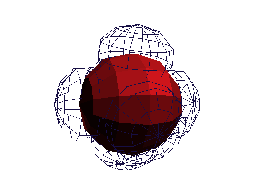|
Contacts: Ms. Chris Byrne | |
| Education | |
| Training | |
| Related Papers | |
| Learning Center Home |
High School Chemistry Education and Virtual Reality
Chemistry World
Ph.D. candidate Chris Byrne studied the use of VR as an educational tool. As part of her dissertation and with support from HIT Lab colleagues, Chris created a virtual chemistry world in which participants form atoms and molecules from the basic building blocks of electrons, protons and neutrons. Participants also control the energy level and spin of electrons which determine where the electrons will go when they are released in the world. The world is a balance of theoretically real objects following the laws of chemistry along with symbolism to help participants interpret the information. For example, the protons look like plus signs and when electrons are placed in an atom, objects appear that represent orbitals.
An experiment was conducted in the Summer of 1993 in which 40 high school chemistry students experienced the virtual chemistry world and assembled a water molecule. The students were given pre and post tests in order to ascertain their knowledge about ato mic and molecular structure and to see if any improvement occurred due to their experience in the virtual world. Each test had one written portion and one oral portion. The written part was a standard chemistry test that was similar to what the students w ould find in their chemistry class. The oral part asked questions about their conceptuali-zation of the topic without requiring them to demonstrate usage of the concepts. For example, questions on the written test asked students to fill out an orbital dia gram while on the oral test they were asked to describe an orbital and what it looked like.
The results of the experiment indicated VR is an effective educational tool. There is a significant improvement at an alpha = .01 for the mean of the oral test. The mean of the written test also shows an significant improvement, although at an alpha = .05. The importance of these results is that they support the belief that VR is powerful in helping students form conceptual models. Many people can learn the rules of a particular topic, such as chemistry, without understanding the underlying principles. A fair number of subjects did well on the written test and poorly on the oral one.
This study, together with Chris' future studies and the pedagogical results of the VRRV program, will begin to quantify what VR can do for kids and how it will impact the classroom experience in the next millennium.
